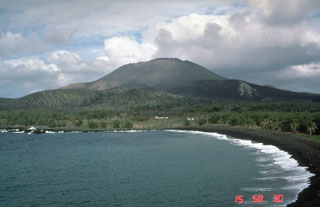Report on Pagan (United States) — August 1987
Scientific Event Alert Network Bulletin, vol. 12, no. 8 (August 1987)
Managing Editor: Lindsay McClelland.
Pagan (United States) Small eruption cloud; 1981 scoria has flowed into village
Please cite this report as:
Global Volcanism Program, 1987. Report on Pagan (United States) (McClelland, L., ed.). Scientific Event Alert Network Bulletin, 12:8. Smithsonian Institution. https://doi.org/10.5479/si.GVP.SEAN198708-284170
Pagan
United States
18.13°N, 145.8°E; summit elev. 570 m
All times are local (unless otherwise noted)
L.G. Eldredge visited Pagan for a few hours on 4 June. The only visible activity was steam emission from the crater. Scoria from the 1981 eruption appeared to have become a slurry-like material during the past 3 years, flowing into the village where it had filled rooms at the infirmary and reached almost to the roof of the school.
The 6 September edition of the Guam Sunday News included a photograph that showed a moderately dense cloud rising perhaps 1 km from the summit of Pagan during what was described as an eruption in the morning of 4 September.
Geological Summary. Pagan Island, the largest and one of the most active of the Mariana Islands volcanoes, consists of two stratovolcanoes connected by a narrow isthmus. Both North and South Pagan stratovolcanoes were constructed within calderas, 7 and 4 km in diameter, respectively. North Pagan at the NE end of the island rises above the flat floor of the northern caldera, which may have formed less than 1,000 years ago. South Pagan is a stratovolcano with an elongated summit containing four distinct craters. Almost all of the recorded eruptions, which date back to the 17th century, have originated from North Pagan. The largest eruption during historical time took place in 1981 and prompted the evacuation of the sparsely populated island.
Information Contacts: L. Eldredge, Univ of Guam.

